Kamaboko, the Star of Year-End and New Year's Feasting
In the last column of the year for The Japan Times, I've written about the symbolic meaning of the many items in osechi ryouri, the traditional New Year's feast eaten in Japan: Savor the symbolism at New Year's.
I've written about osechi on this site previously also - Everything in osechi ryouri, where I also confess that I don't actually like most of the items in osechi that much personally! I've also written about toshikoshi soba or year-ending (or year-bridging) soba, which is eaten on New Year's Eve.
One item that's often included in both toshikoshi soba and osechi ryouri is kamaboko (蒲鉾 or かまぼこ), a rubbery and firm fish cake that also makes its appearance year-round in everything from ramen to bentos. While in its natural state it's a creamy white in color, it often comes dyed, pink being the most common coloring. It's also the forerunner of other types of food that have become more famous around the world.
Since red and white (kōhaku) is a very lucky color combination in Japan, alternating pink and white slices of kamaboko are seen often in osechi.
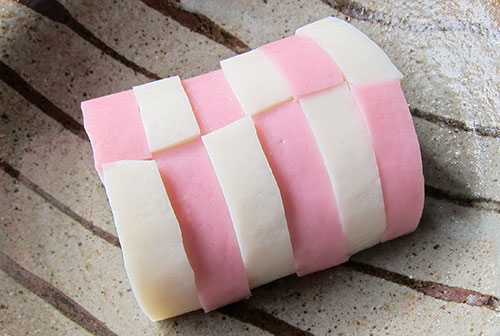
This is an ad from a high-end kamaboko maker, which puts gold leaf on their special occasion kamaboko. The brown color comes from lightly grilling the outside of a formed kamaboko cake.
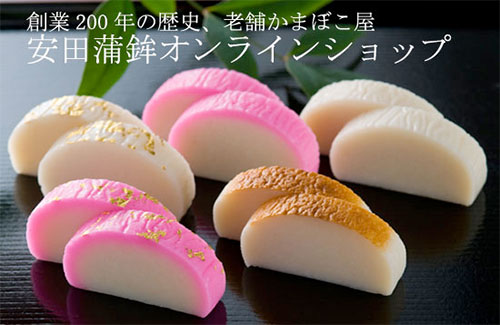
Many regions of Japan has their version of kamaboko. It used to be made with white freshwater fish as well as sea fish, but nowadays it's mainly made with white sea fish such as cod and various cod substitutes, together with some kind of starch - usually potato starch, but sometimes other starches from corn or wheat are used too. Here's a type of kamaboko made in Toyama prefecture on the Japan Sea coast, which combines the white paste (called surimi) with konbu seaweed. The green coloring is pretty unusual too.
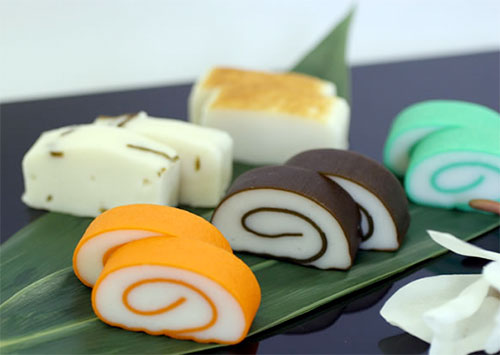
Most kamaboko has shaped like a half-moon or demi-circle on top of a small piece of wood. As a child I used to collect these bits of woods (called kamaboko-ita) and use them for school projects. I even once made a small bookshelf out of kamaboko-ita for my desk, although it and the desk are long gone now. Kamaboko comes in many other shapes too.
When red and white kamaboko are formed into a rolled spiral shape before steaming, it's called naruto or narutomaki. You may have seen slices of naruto floating on top of a bowl of ramen. Some instant cup noodles even include freezedried versions. This page has a good picture of naruto. I don't think the anime Naruto comes from narutomaki though - naruto also means 'whirling water'.
Kamaboko is also the forerunner of crab sticks or fake crab meat, which is called kanikama or "crab kamaboko" in Japan. The same type of surimi or fish paste is flavored to ressemble crab, extruded into crabmeat like strands, dyed and formed into sticks. Kanikama was first made by a fish processing company in Ishikawa prefecture, which neighbors Toyama prefecture on the Japan Sea coast, in 1973. Apparently it was never meant to be faux crab meat, but a different kind of kamaboko. I think that as long as you think of it as a kind of fish sausage and not as well, imitation crab, it's fine. But since it's become so popular worldwide there's a lot of really bad crab stick out there, so you need to shop around.
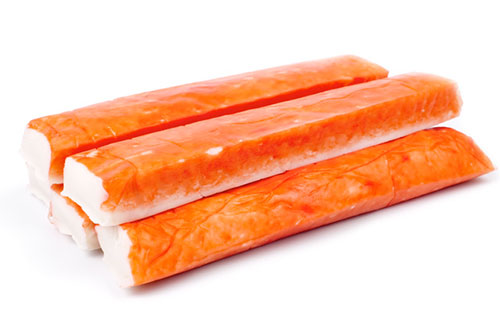
Getting back to kamaboko: Since it is so flexible and rubbery in texture, it can be cut into all kinds of decorative forms. This image is from the Kibun site. (Kibun is a major kamaboko and other processed foods manufacturer.)
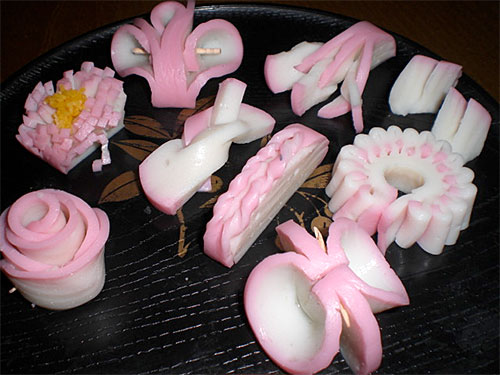
Indeed, decorative cutting of kamaboko is the forerunner of another kind of decorative food cutting that has become known worldwide these days - the decoratively cut weiner sausage.
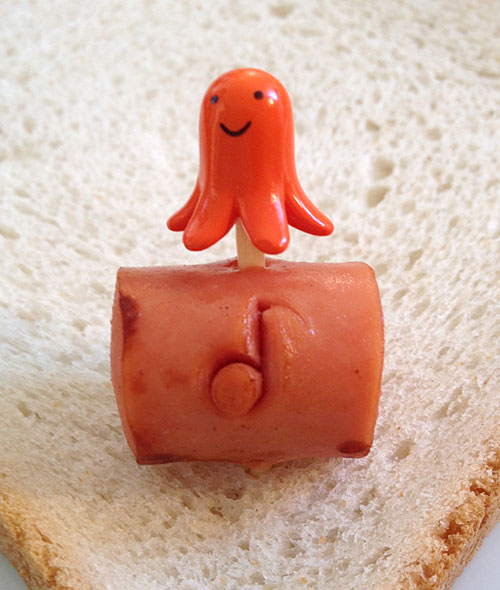
The simplest ways to enjoy kamaboko are to just drop a slice or two on top of a bowl of hot noodle soup, or to enjoy slices like sashimi with plain rice. It is not something you can make easily at home (believe me, I've tried) so if you have a Japanese grocery store, buy a half-moon pack, slice it up and enjoy!
If you enjoyed this article, please consider becoming my patron via Patreon. ^_^

 Welcome to Just Hungry, where we serve authentic Japanese recipes and more! I'm
Welcome to Just Hungry, where we serve authentic Japanese recipes and more! I'm 














Comments
Fono
29 December, 2012 - 17:42
Permalink
Re: Kamaboko, the Star of Year-End and New Year's Feasting
Hi Makiko!
First i want to congrats you for your blog wihich i have benn reading since i got brack from japan this summer. Your consideration about food has been a great inspiration for me.
Well i got some kamabuko at some japanese/asian store in Paris but it comes frozen. As i'am not really sure about how long it keeps in the fridge once defrosted i'am afraid to use it. Do you have any advice about frozed kamaboko?
Shall i try to slice it frozen?
Kind regards
maki
29 December, 2012 - 21:56
Permalink
Re: Kamaboko, the Star of Year-End and New Year's Feasting
I often do slice from a frozen block of kamaboko, and leave the rest of it frozen so that it can go back in the freezer (well wrapped). The slices defrost pretty fast.
anon.
29 December, 2012 - 21:57
Permalink
Re: Kamaboko, the Star of Year-End and New Year's Feasting
Kamaboko used to be edible in the past. But now they can be used as rubber balls. They are inedible and won't rot! I refuse to buy them even for decoration. They are just a waste of time!
maki
29 December, 2012 - 22:02
Permalink
Re: Kamaboko, the Star of Year-End and New Year's Feasting
You may need to look for better quality kamaboko...which is still quite delicious.
anon.
30 December, 2012 - 21:53
Permalink
Re: Kamaboko, the Star of Year-End and New Year's Feasting
So that's what that rubbery white thing was with a littel pink around the edge, i can't see hte pictures now that I'm blind but I got abento box and some Soba noodles with some chicken and a couple slices of this were on hte chicken and it was so good, I just had no ide awhat it was at all. I'm glad to know now what it was, unfortunately I'm not in the area I was able to get bento lunches from, but it was always good. I miss the bubble tea terribly.
Thanks for htis, I found this by accident from another article when I read the year end Soba noodle recipe.
Supertaster
31 December, 2012 - 15:09
Permalink
Re: Kamaboko, the Star of Year-End and New Year's Feasting
Welcome back! I've really missed your posts. Hope you're feeling better.
I LOVE kamaboko and never realized that it could be so fun and festive! Thank you for the pictures and info. Happy New Year!!
The Elf
2 January, 2013 - 03:43
Permalink
Re: Kamaboko, the Star of Year-End and New Year's Feasting
That's what that stuff is called! I've seen it in soups lots of times. I've enjoyed the flavor and texture, but wasn't quite sure what I was eating.
I've bought surimi - most commonly as imitation crab - and used it many times for an easy protein boost in an otherwise vegetarian meal. It's versatile, healthy, and lasts a long time in storage.
When I next head to Lotte, I'll look for Kamaboko. Lately, I've taken excerpts from your posts so I can compare the Japanese words with what is on the package - otherwise it's sometimes a gamble at the store! I can't wait to try it like sashimi.
Welcome back!
lee
2 January, 2013 - 21:53
Permalink
Re: Kamaboko, the Star of Year-End and New Year's Feasting
Hi Maki. I'm glad you made the post on kamaboko! I recently found Naruto Kamaboko in my freezer thats never been opened... I think I bought it a year ago, is it still good to use? Should I thaw it out first before using?
maki
3 January, 2013 - 09:09
Permalink
Re: Kamaboko, the Star of Year-End and New Year's Feasting
If it's been in the freezer all along and never opened, it should still be fine. But you may want to use it up soon though.
Hikari
3 January, 2013 - 02:57
Permalink
Re: Kamaboko, the Star of Year-End and New Year's Feasting
So glad to see you blogging again! You're one of the reasons I started blogging my food adventures!
Finally made some Ozoni this year and used the pink/white kamaboko. LOVED it!
Hope this year is the best one yet!
anon.
4 January, 2013 - 13:52
Permalink
Re: Kamaboko, the Star of Year-End and New Year's Feasting
Funnily enough, in later chapters of Naruto, it was revealed that the main character was named for a character in a book -- and that the author had had writer's block on the name, until he ate a bowl of ramen! So according to the story, he was indeed named after narutomaki (the reveal was even funnier because the main character loves ramen so much himself).
NyNy
8 January, 2013 - 18:26
Permalink
Re: Kamaboko, the Star of Year-End and New Year's Feasting
Ah, so it's kind of like a fishcake? Interesting!
Lod Repon
9 January, 2013 - 12:15
Permalink
Re: Kamaboko, the Star of Year-End and New Year's Feasting
This is a smart blog. I mean it. You have so much knowledge about this issue, and so much passion. You also know how to make people rally behind it, obviously from the responses. You’ve got a design here that’s not too flashy, but makes a statement as big as what you’re saying. Great job, indeed. http://bit.ly/qbzake